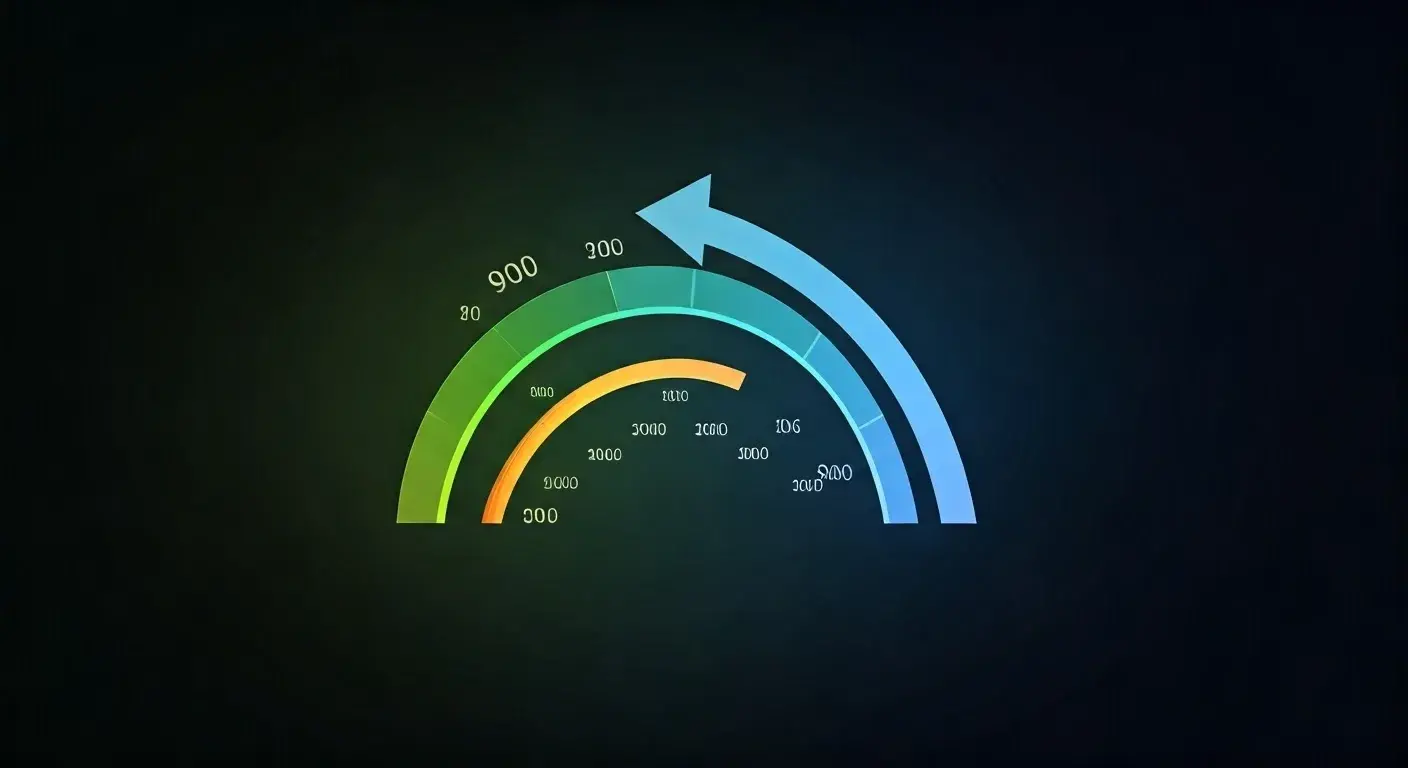-
Posted on: 21 Dec 2022

-
Unlock the secrets to a stellar credit score with our straightforward guide. Discover 8 easy steps designed to boost your financial health, making borrowing easier and saving you money. Start your journey to credit improvement today!
Understanding Your Credit Score
Before diving into improvement strategies, it's crucial to grasp what a credit score is and why it matters. Your credit score is a three-digit number, typically ranging from 300 to 850, that lenders use to assess your creditworthiness. It's a snapshot of your financial behavior, reflecting how likely you are to repay borrowed money. A higher score signifies lower risk to lenders, translating into better interest rates on loans, easier approval for mortgages and car loans, and even lower insurance premiums. In 2025, the average credit score in the United States hovers around 715, but this number can vary significantly based on demographics and financial habits. Understanding the factors that influence your score is the first step toward improving it.
Key Factors Influencing Your Credit Score
Credit scoring models, like FICO and VantageScore, consider several key components when calculating your score. While the exact weighting can differ slightly, the primary drivers remain consistent. These include:
- Payment History (35%): This is the most critical factor. It reflects whether you pay your bills on time. Late payments, defaults, and bankruptcies can severely damage your score.
- Amounts Owed (30%): This refers to your credit utilization ratio – the amount of credit you're using compared to your total available credit. Keeping this ratio low is vital.
- Length of Credit History (15%): The longer you've had credit accounts open and managed them responsibly, the better it is for your score.
- Credit Mix (10%): Lenders like to see that you can manage different types of credit, such as credit cards, installment loans (like mortgages or auto loans), and personal loans.
- New Credit (10%): Opening multiple new credit accounts in a short period can signal increased risk.
By understanding these pillars, you can strategically focus your efforts on the areas that will yield the most significant improvements.
Step 1: Obtain and Review Your Credit Reports
The foundation of any credit improvement plan is knowing your starting point. This involves obtaining your credit reports from the three major credit bureaus: Equifax, Experian, and TransUnion. These reports contain detailed information about your credit history, including your payment history, outstanding debts, credit accounts, and any public records like bankruptcies or collections.
Why Reviewing Your Reports is Crucial
Credit reports are the raw data that credit scoring models use. Errors on these reports are surprisingly common and can significantly and unfairly lower your credit score. These errors can include incorrect personal information, accounts that don't belong to you, inaccurate late payment notations, or incorrect balances. In 2025, the Federal Trade Commission (FTC) continues to receive a substantial number of consumer complaints regarding credit report inaccuracies, highlighting the ongoing need for vigilance.
How to Get Your Free Credit Reports
Thanks to the Fair Credit Reporting Act (FCRA), you are entitled to a free credit report from each of the three major bureaus once every 12 months. The official source for these free reports is AnnualCreditReport.com. Due to ongoing efforts to improve consumer access, some services may offer more frequent free access.
Actionable Tip: Request your reports from all three bureaus simultaneously. This allows for a comprehensive comparison and helps identify discrepancies across the different reporting agencies. Dedicate time to meticulously go through each section of your reports.
Step 2: Dispute Any Errors on Your Reports
Once you've obtained and reviewed your credit reports, the next critical step is to dispute any inaccuracies you find. This process is your right as a consumer and is essential for ensuring your credit score accurately reflects your financial behavior.
Common Types of Errors
Errors can range from minor to major. Some common ones include:
- Incorrect Personal Information: Wrong address, social security number, or employment history.
- Accounts You Don't Recognize: This could be due to identity theft or a reporting error.
- Incorrect Payment Status: A payment marked as late when it was actually made on time.
- Duplicate Accounts: The same debt listed multiple times.
- Outdated Information: Negative information that should have been removed from your report after the statutory period (typically seven years, or ten for bankruptcy).
The Dispute Process
The FCRA mandates that credit bureaus investigate disputes within a reasonable period, usually 30 days (or 45 days if you provide new information during the initial 30-day period).
- Gather Evidence: Collect any documentation that supports your claim (e.g., payment receipts, statements, correspondence with creditors).
- Contact the Credit Bureau: You can typically initiate a dispute online, by mail, or by phone through each bureau's website. Online disputes are often the fastest.
- Write a Dispute Letter: If disputing by mail, send a clear, concise letter detailing the error and attaching copies of your evidence. Keep the original documents.
- Follow Up: The credit bureau will contact the furnisher of the information (e.g., your credit card company) to verify its accuracy. If the furnisher cannot verify the information, it must be corrected or removed.
Example: If you find an account from a store you've never shopped at, you would dispute it as "not yours" and provide any supporting evidence you have, like stating you've never lived at an address associated with that account.
Statistic: According to the Consumer Financial Protection Bureau (CFPB) in 2025, a significant percentage of consumers who dispute errors see corrections made to their credit reports, demonstrating the effectiveness of this step.
Step 3: Prioritize On-Time Payments
As mentioned earlier, payment history is the single most significant factor influencing your credit score, accounting for approximately 35% of the calculation. Consistently making on-time payments is paramount to building and maintaining a healthy credit profile.
The Impact of Late Payments
Even a single late payment can have a substantial negative impact on your credit score. The severity of the impact depends on how late the payment is (30, 60, or 90+ days past due) and your credit score before the delinquency. A 30-day late payment is less damaging than a 90-day delinquency, which can significantly drop your score and remain on your report for up to seven years.
Strategies for Ensuring On-Time Payments
If you struggle with remembering due dates, several strategies can help:
- Set Up Automatic Payments: Most lenders offer automatic payment options. Ensure you have sufficient funds in your account to cover the payment to avoid overdraft fees and missed payments.
- Use Calendar Reminders: Set up alerts on your phone, computer, or a physical calendar a few days before each bill is due.
- Budgeting: Create a detailed budget to track your income and expenses, ensuring you allocate funds for all your financial obligations.
- Consolidate Due Dates: If possible, try to align your due dates for various bills to a few days each month. This simplifies tracking.
- Contact Lenders Proactively: If you anticipate difficulty making a payment, contact your lender *before* the due date. They may be willing to offer a grace period or a payment plan.
Example: If your credit card payment is due on the 15th, and you typically get paid on the 10th, setting up an automatic payment from your checking account on the 12th ensures the funds are available and the payment is made before it's late.
2025 Insight: Financial experts in 2025 continue to emphasize that even with a low credit score, demonstrating a consistent pattern of on-time payments over a period of 6-12 months can lead to a noticeable improvement in your score.
Step 4: Manage Your Credit Utilization Ratio
Your credit utilization ratio (CUR) is the second most important factor in your credit score, accounting for about 30%. It measures the amount of revolving credit you're using compared to your total available revolving credit. For example, if you have a credit card with a $10,000 limit and you owe $3,000 on it, your CUR for that card is 30%.
Why a Low CUR is Key
A high CUR signals to lenders that you might be overextended and at a higher risk of defaulting on your debts. Lenders generally prefer to see a CUR below 30%, and scores tend to be highest when the CUR is below 10%.
Strategies to Lower Your Credit Utilization
There are several effective ways to reduce your credit utilization:
- Pay Down Balances: The most direct method is to pay down your outstanding credit card balances. Focus on paying more than the minimum payment whenever possible.
- Increase Your Credit Limit: Contact your credit card issuers and request a credit limit increase. If approved, this can lower your CUR without you spending more, provided your spending remains the same. Be cautious, as some issuers may perform a hard inquiry.
- Spread Out Your Spending: If you have multiple credit cards, try to distribute your spending across them rather than maxing out one card.
- Avoid Closing Unused Credit Cards: Closing a credit card reduces your total available credit, which can increase your CUR even if your spending hasn't changed.
Example: If you have a $5,000 balance on a card with a $10,000 limit (50% CUR) and another card with a $2,000 balance on a $5,000 limit (40% CUR), your overall CUR is ($5,000 + $2,000) / ($10,000 + $5,000) = $7,000 / $15,000 = 46.7%. By paying down the first card to $2,000, your overall CUR drops to ($2,000 + $2,000) / ($10,000 + $5,000) = $4,000 / $15,000 = 26.7%, a significant improvement.
2025 Trend: Credit scoring models are becoming more sophisticated, but the principle of low credit utilization remains a cornerstone of a good score. Financial advisors in 2025 recommend keeping your overall CUR below 30% and ideally below 10% for optimal results.
Step 5: Understand and Leverage Credit Age
The length of your credit history, also known as credit age, is another important factor, typically accounting for about 15% of your credit score. Lenders view a longer history of responsible credit management as a sign of stability and lower risk.
What Constitutes Credit Age?
Credit age is generally calculated in two ways:
- Average Age of All Accounts: This is the average time since your credit accounts were opened.
- Age of Oldest Account: The age of your very first credit account that is still open.
Both metrics are considered, but the age of your oldest account often carries more weight.
How to Improve Your Credit Age
Improving credit age is a long-term strategy that requires patience. You can't artificially speed up time, but you can avoid actions that harm it.
- Keep Old Accounts Open: Even if you don't use an old credit card frequently, keeping it open (and in good standing) contributes positively to your average account age. If it has an annual fee, consider if the benefits outweigh the cost. If not, you might consider closing it, but be aware of the potential impact.
- Avoid Opening Too Many New Accounts at Once: As discussed in Step 6, frequent new account openings can lower your average credit age.
- Become an Authorized User: If a trusted family member or friend with excellent credit history adds you as an authorized user to their long-standing credit card, their account's positive history can benefit your credit age. However, ensure they manage the account responsibly, as their mistakes can also affect you.
Example: If your oldest account was opened 10 years ago, and your newest was opened 6 months ago, your average credit age will be significantly lower than if all your accounts were several years old. Keeping that 10-year-old account active is crucial.
2025 Perspective: While new credit and utilization are more immediately actionable, the importance of a long, stable credit history remains a cornerstone. Financial planning resources in 2025 emphasize that patience is a virtue when it comes to credit age, and responsible management over many years is rewarded.
Step 6: Be Strategic About New Credit Applications
Opening new credit accounts can be beneficial for building credit, but applying for too much credit too quickly can be detrimental. This factor, known as "new credit," typically accounts for about 10% of your credit score.
Understanding Hard and Soft Inquiries
When you apply for credit, lenders typically perform a "hard inquiry" on your credit report. Each hard inquiry can cause a small, temporary dip in your credit score. Multiple hard inquiries within a short period can signal to lenders that you're in financial distress or taking on a lot of new debt, increasing your risk.
"Soft inquiries," on the other hand, occur when you check your own credit score or when companies check your credit for pre-approved offers. These do not affect your credit score.
When to Apply for New Credit
Applying for new credit should be a deliberate decision, not an impulse.
- Only When Necessary: Apply for credit only when you genuinely need it, such as for a mortgage, a car loan, or a credit card to consolidate debt or build credit.
- Shop Around Strategically: If you're applying for a mortgage or auto loan, you can shop around for the best rates within a specific timeframe (usually 14-45 days, depending on the scoring model). Multiple inquiries for the same type of loan within this window are often treated as a single inquiry by scoring models.
- Avoid Multiple Applications for Revolving Credit: Applying for several new credit cards simultaneously is generally not advisable and will likely lower your score.
- Consider Secured Credit Cards: If you have a low credit score or no credit history, a secured credit card is an excellent way to build credit responsibly. You provide a cash deposit, which becomes your credit limit.
Example: If you're looking for a new car, you might apply for pre-approval from your bank, then visit dealerships. Applying for financing at multiple dealerships on the same day for the same car loan is generally okay, but applying for three new credit cards and a personal loan in the same week is likely to hurt your score.
2025 Advice: Credit experts in 2025 emphasize that while new credit inquiries have a relatively small impact, they are still a factor. Prudent application strategies are key to avoiding unnecessary score damage.
Step 7: Diversify Your Credit Mix (Carefully)
The types of credit you manage, known as your credit mix, account for about 10% of your credit score. Lenders like to see that you can handle different forms of credit responsibly.
Understanding Different Credit Types
There are two main categories of credit:
- Revolving Credit: This includes credit cards and home equity lines of credit (HELOCs). You have a credit limit, and you can borrow and repay funds repeatedly.
- Installment Credit: This includes loans with fixed monthly payments and a set repayment period, such as mortgages, auto loans, student loans, and personal loans.
How to Improve Your Credit Mix
A healthy credit mix often includes both revolving credit and installment loans. However, this is a factor that should not be forced or pursued aggressively.
- Don't Open Accounts Solely for Mix: The primary goal should always be to manage your existing credit responsibly. Opening a new loan or credit card just to diversify your mix can backfire if you can't manage it well or if it leads to too many inquiries.
- Focus on Existing Accounts: If you already have a good mix (e.g., a credit card and an auto loan), focus on managing them perfectly.
- Consider a Small Personal Loan: If you have only revolving credit and no installment loans, and you can comfortably afford the payments, a small, manageable installment loan could potentially help diversify your mix over time. However, this is a lower-priority step compared to payment history and utilization.
Example: Someone with only credit cards might consider taking out a small personal loan for a planned purchase (if financially prudent) to introduce an installment loan into their credit profile.
2025 Outlook: While credit mix is a factor, its impact is less significant than payment history and credit utilization. Financial advisors in 2025 suggest that individuals with a solid credit history and good management of their current accounts shouldn't stress excessively about achieving a perfect credit mix. Focus on the fundamentals first.
Step 8: Practice Responsible Borrowing Habits
This overarching principle ties together all the previous steps. Responsible borrowing is about making smart financial decisions that demonstrate to lenders that you are a reliable borrower.
Key Habits of Responsible Borrowers
Beyond the specific steps, cultivating a mindset of financial responsibility is crucial.
- Live Within Your Means: Avoid accumulating debt that you cannot comfortably repay.
- Understand Loan Terms: Before taking out any loan or credit card, thoroughly read and understand the interest rates, fees, repayment terms, and any other conditions.
- Avoid Predatory Lending: Steer clear of high-interest payday loans or title loans, which can trap you in a cycle of debt.
- Build an Emergency Fund: Having savings can prevent you from needing to rely on high-interest credit in unexpected situations.
- Regularly Monitor Your Financial Health: Make it a habit to review your credit reports and bank statements regularly.
Example: Instead of using a credit card for everyday purchases and paying high interest, a responsible borrower might use a debit card or a credit card only for specific planned expenses and pay the balance in full each month.
2025 Financial Literacy: The emphasis in 2025 on financial literacy programs highlights the importance of responsible borrowing as a foundational skill for long-term financial well-being. It's not just about having a good score, but about building a sustainable financial future.
Long-Term Credit Health Strategies
Improving your credit score is not a one-time event but an ongoing process. By consistently applying the 8 easy steps outlined above, you'll be well on your way to achieving and maintaining excellent credit. Remember that credit scores fluctuate, and it takes time to see significant improvements. Patience and discipline are your greatest allies.
Maintaining Your Improved Score
Once you've reached your desired credit score, the focus shifts to maintenance. This involves continuing to practice good financial habits:
- Consistent On-Time Payments: This remains the most critical factor.
- Low Credit Utilization: Aim to keep your credit card balances low.
- Monitor Your Credit Reports: Periodically check your reports for any new errors or fraudulent activity.
- Avoid Unnecessary Credit Applications: Be mindful of how often you apply for new credit.
2025 Economic Outlook: In the current economic climate of 2025, a strong credit score is more valuable than ever. It provides financial resilience, access to better rates, and peace of mind. By diligently following these steps, you are investing in your financial future and opening doors to greater opportunities.
In conclusion, improving your credit score is an achievable goal with the right approach. By understanding the components of your score, diligently reviewing and correcting your credit reports, prioritizing timely payments, managing credit utilization, and practicing responsible borrowing, you can significantly enhance your financial standing. These 8 easy steps, when implemented consistently, will not only boost your credit score but also pave the way for a more secure and prosperous financial future. Start today, and watch your credit health flourish.











